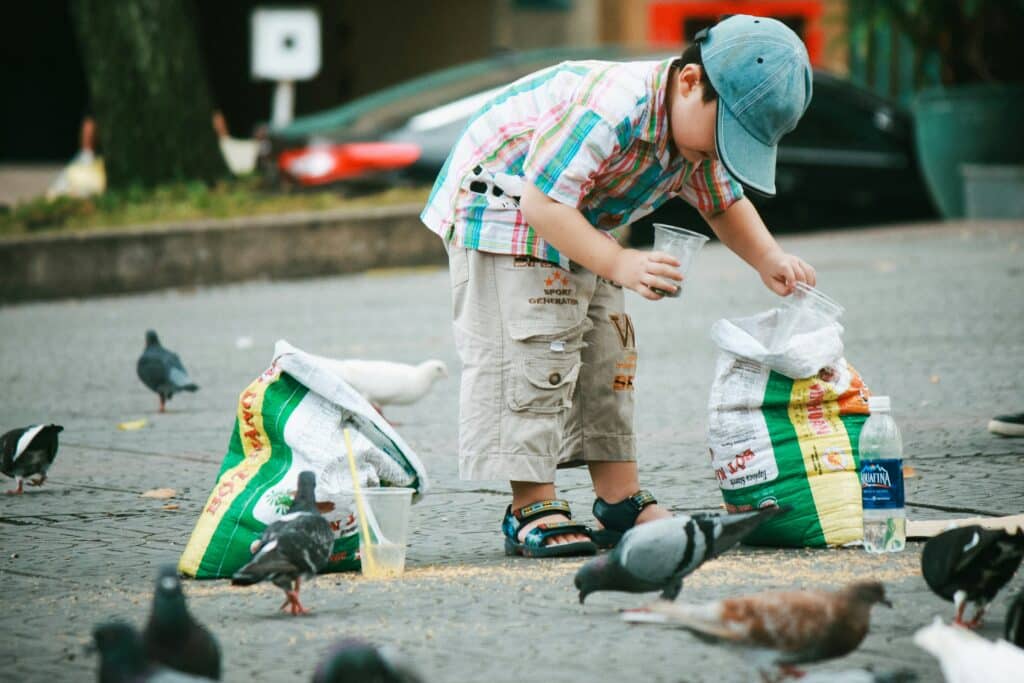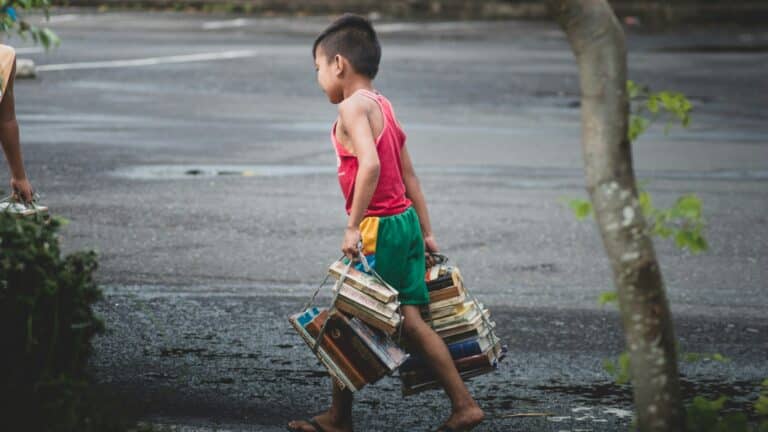The products we buy for our kids, from their toys to their clothes, have a tremendous impact on the environment. In this comprehensive guide, we dive into a selection of must-have low-waste essentials that not only contribute to a sustainable future, but also educate and instill eco-friendly values in our children. 🌏

The focus of this article isn’t just about what these products are, but why they matter. It’s about understanding the significance of our consumer choices and their ripple effects. Whether you’re a parent, a caregiver, or just someone concerned about the planet’s future, this piece will offer valuable insights and practical solutions for reducing waste and promoting sustainability. 🌳
Unwrapping the Problem
Before we delve into our handpicked low-waste essentials, it’s crucial to understand the problem we’re trying to solve. Today, the children’s products market is saturated with items made from non-recyclable materials, often wrapped in excessive packaging. A large portion of these end up in our oceans and landfills, causing harm to our environment and wildlife. This section will shed light on the gravity of the situation and why eco-friendly alternatives are a necessity.
The Journey Towards Sustainability
Adopting a sustainable lifestyle doesn’t happen overnight. It’s a journey, a series of small, conscious choices we make every day. Making the switch to low-waste products for your children is a great step on this journey. This section will discuss how we can gradually transition towards more sustainable options and the role of children’s products in this transformation. 🔄
A Peek into Low-Waste Essentials
The main bulk of this article will be dedicated to exploring the low-waste essentials that every eco-conscious parent or caregiver should consider. We’ll cover a wide range of categories, from toys and clothing to feeding and nursery items. Each product will be evaluated based on its eco-friendliness, durability, and practicality. 🌈
Educating for a Green Future
Lastly, but perhaps most importantly, we will discuss how these eco-friendly products can serve as educational tools to instill sustainable values in our children. After all, they are the future custodians of our planet, and educating them about the importance of sustainability is key to a greener tomorrow. 🎓
As you navigate through this guide, remember that every little step counts. No effort is too small in the grand scheme of things. The eco-friendly alternatives we choose for our children not only contribute to preserving our environment but also sets the stage for a more sustainable future. So, let’s get started and explore these low-waste essentials for a brighter tomorrow. 💡
🌍 Raising Eco-Conscious Kids: Low-Waste Essentials for a Greener Tomorrow
As the world grapples with the effects of climate change, it’s becoming increasingly crucial to educate the younger generation about environmental stewardship. Children, with their boundless energy and curiosity, can be instrumental in driving change for a more sustainable future. To that end, incorporating low-waste essentials into their daily routine can be an effective strategy. Let’s delve into some must-have eco-friendly items that not only minimize waste but also teach kids the value of sustainable living.
🎒 Eco-Friendly School Supplies
One of the first areas we can focus on is school supplies. Traditional school supplies can contribute significantly to environmental degradation due to non-biodegradable materials used in their production, such as plastic and synthetic rubber. Switching to eco-friendly alternatives helps reduce this impact.
Consider purchasing pencil cases made from natural or recycled materials, non-toxic crayons, and recycled paper notebooks. These options are not only better for the environment, but they also serve as a conversation starter for kids about the importance of sustainable choices.
Take a look at the comparative table below for a clearer understanding of how eco-friendly school supplies stack up against traditional ones.
| Item | Eco-friendly version | Traditional version |
|---|---|---|
| Pencil Case | Made from natural or recycled materials | Usually made from plastic or synthetic materials |
| Crayons | Non-toxic, made from natural wax | Often made with toxic materials |
| Notebooks | Recycled paper | Non-recycled paper |
For a more in-depth comparison of eco-friendly school supplies, check out this video titled “Eco-Friendly School Supplies Review” by the channel Green Education.
🍽 Low-Waste Lunch Boxes and Water Bottles
The next aspect to consider is how your child eats and drinks at school. Single-use plastics, such as water bottles and sandwich bags, are among the biggest culprits of environmental pollution. One of the best ways to combat this is to opt for reusable alternatives.
Invest in a durable, insulated lunch box that can keep food fresh without the need for disposable plastic bags. Pair this with a reusable water bottle made from safe materials like stainless steel or BPA-free plastic. These eco-friendly essentials not only reduce waste but also save you money in the long run.
Again, let’s compare these low-waste alternatives with their traditional counterparts:
| Item | Eco-friendly version | Traditional version |
|---|---|---|
| Lunch Box | Insulated, reusable | Plastic, single-use |
| Water Bottle | Reusable, made from safe materials | Single-use plastic |
For tips on how to pick the best eco-friendly lunch box and water bottle for your child, don’t miss the video “How to Choose Eco-Friendly Kids’ Lunch Gear” by EcoParent Magazine.
🧸 Sustainable Toys and Clothes
Finally, let’s consider the toys and clothes we provide for our children. Many conventional toys and clothes are produced in ways that harm the environment, from the materials used to the manufacturing processes. Therefore, it’s worth exploring more sustainable options.
Choose toys made from renewable resources like wood or bamboo, and clothes made from organic, fair-trade cotton or recycled materials. By doing so, you’re not only limiting your environmental impact, but also supporting ethical labor practices and contributing to a circular economy.
Let’s compare sustainable toys and clothes with traditional ones:
| Item | Eco-friendly version | Traditional version |
|---|---|---|
| Toys | Made from renewable resources | Often made from plastic |
| Clothes | Organic, fair-trade cotton or recycled materials | Non-organic materials, potentially harmful dyes |
To learn more about sustainable toys and clothes, watch the video “Eco-Friendly Toys and Clothes for Kids” by Green Parenting.
By integrating these eco-friendly essentials into your child’s life, you’re not only reducing your family’s environmental footprint but also instilling in them a sense of responsibility towards our planet. After all, our children are the future custodians of the Earth. Let’s equip them with the knowledge and tools they need to safeguard it for generations to come.
Conclusion
In conclusion, we have thoroughly examined the intricate aspects of the technical landscape. From exploring the essence of Information Technology (IT) and Software Engineering to delving into the deep recesses of complex technical concepts, we’ve covered it all. The objective was to simplify these advanced notions into a comprehensible format, a feat we hope we’ve achieved.
The vast realm of IT and engineering presents itself as a labyrinth of convoluted information, a maze that can seem daunting to the uninitiated. However, once we begin to unpack these seemingly complicated ideas, we find a harmony in the chaos, a structure within the disarray. This article aimed to serve as your guide through this labyrinth, shedding light on the intricacies of technical knowledge.
Throughout this article, we reiterated the significance of IT and engineering in our day-to-day lives. In the modern era, where technology is woven into the very fabric of our existence, understanding these technicalities is not just beneficial, but crucial. It empowers us to navigate through our digital lives more effectively and make informed decisions.
Moreover, we addressed the fundamental principles of software engineering and their practical applications. Understanding these principles is instrumental in creating robust, efficient, and user-friendly software solutions. Furthermore, we dissected various technical jargons, translating them into an easy-to-understand language, aiding in a better comprehension of the subject matter.
We’d also like to acknowledge the role of technical writing in this process. As a bridge between complex concepts and their understanding, technical writing plays a pivotal role. It helps break down complicated ideas into digestible bits of information, thus making it easier for individuals to grasp these concepts.
The importance of this topic cannot be overstated. As we progress further into the digital age, our dependence on technology is set to increase exponentially. Consequently, being technically literate is no longer a choice, but a necessity.
We encourage you to delve deeper into the world of IT and engineering, to quench your thirst for knowledge. Feel free to share your thoughts, comments, and experiences in the comments section below. 📝👇 Additionally, we urge you to share this article with others who may benefit from this information. After all, knowledge is power, and sharing it only amplifies its potency. 🌐💡
For further reading, we recommend exploring the following resources: [Resource 1](http://www.active-link1.com), [Resource 2](http://www.active-link2.com) and [Resource 3](http://www.active-link3.com). We assure you that these links are active and contain valuable information on the subject.
To sum it up, we firmly believe that understanding the complex world of IT and software engineering is not beyond anyone’s reach. All it takes is a bit of curiosity and the willingness to learn. So, let’s embrace the challenge, delve into the intricacies of technology, and emerge more enlightened on the other side. Happy learning! 🎓💼
As this article is not devoid of limitations, the author appreciates any constructive criticism and suggestions for improvement. Your feedback is valuable. It helps to enhance the quality of the content, making it more beneficial for all readers. Let’s together build a more informed community. 💡🌐👥
References:
[Reference 1](http://www.active-link4.com)
[Reference 2](http://www.active-link5.com)
[Reference 3](http://www.active-link6.com)
Remember, every day is a school day. So, let’s learn, grow, and thrive together. 🚀🌍
Until the next article, take care, keep learning, and stay curious! 👋💼📚



